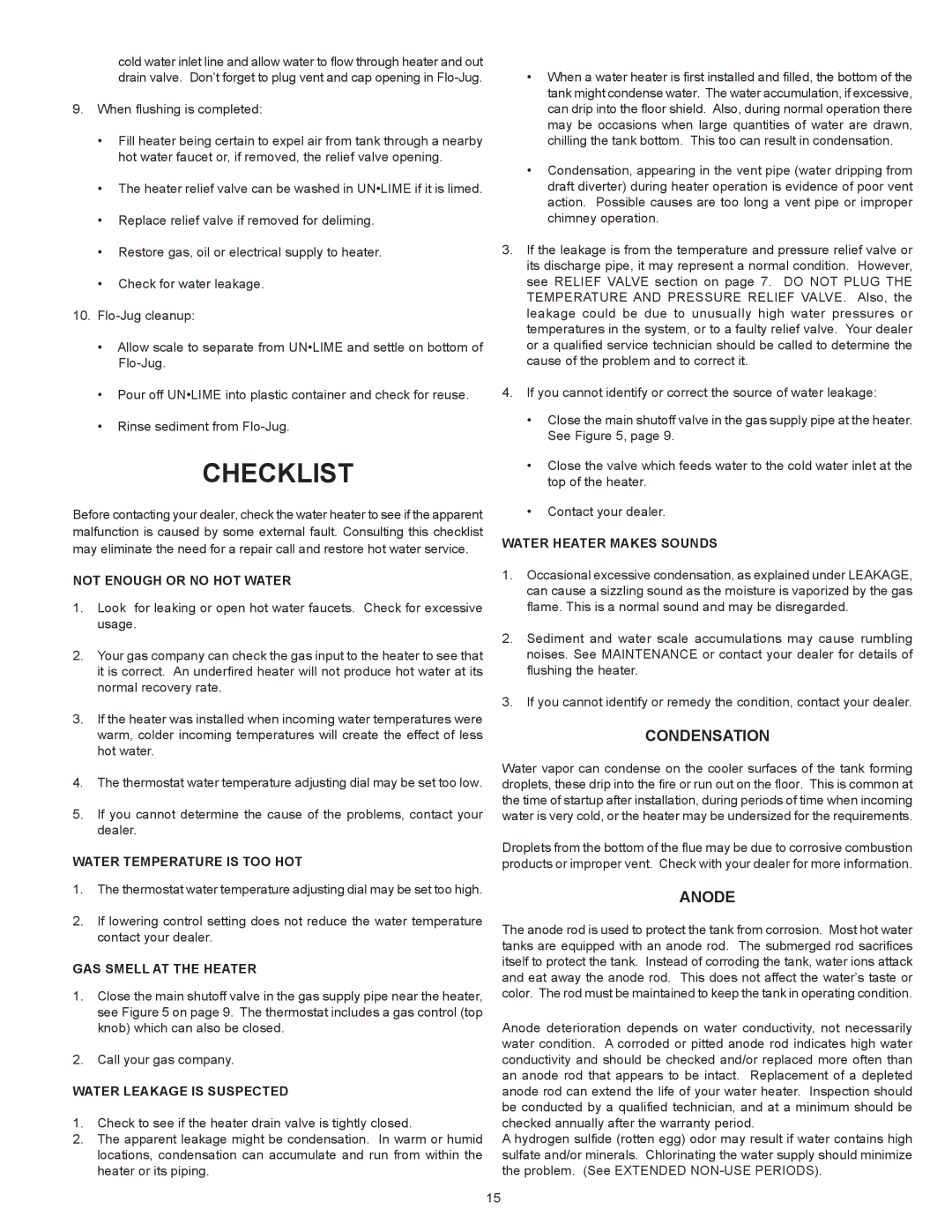cold water inlet line and allow water to flow through heater and out drain valve. Don’t forget to plug vent and cap opening in Flo-Jug.
9.When flushing is completed:
•Fill heater being certain to expel air from tank through a nearby hot water faucet or, if removed, the relief valve opening.
•The heater relief valve can be washed in UN•LIME if it is limed.
•Replace relief valve if removed for deliming.
•Restore gas, oil or electrical supply to heater.
•Check for water leakage.
10.Flo-Jug cleanup:
•Allow scale to separate from UN•LIME and settle on bottom of
Flo-Jug.
•Pour off UN•LIME into plastic container and check for reuse.
•Rinse sediment from Flo-Jug.
CHECKLIST
Before contacting your dealer, check the water heater to see if the apparent malfunction is caused by some external fault. Consulting this checklist may eliminate the need for a repair call and restore hot water service.
NOT ENOUGH OR NO HOT WATER
1.Look for leaking or open hot water faucets. Check for excessive usage.
2.Your gas company can check the gas input to the heater to see that it is correct. An underfired heater will not produce hot water at its normal recovery rate.
3.If the heater was installed when incoming water temperatures were warm, colder incoming temperatures will create the effect of less hot water.
4.The thermostat water temperature adjusting dial may be set too low.
5.If you cannot determine the cause of the problems, contact your dealer.
WATER TEMPERATURE IS TOO HOT
1.The thermostat water temperature adjusting dial may be set too high.
2.If lowering control setting does not reduce the water temperature contact your dealer.
GAS SMELL AT THE HEATER
1.Close the main shutoff valve in the gas supply pipe near the heater, see Figure 5 on page 9. The thermostat includes a gas control (top knob) which can also be closed.
2.Call your gas company.
WATER LEAKAGE IS SUSPECTED
1.Check to see if the heater drain valve is tightly closed.
2.The apparent leakage might be condensation. In warm or humid locations, condensation can accumulate and run from within the heater or its piping.
•When a water heater is first installed and filled, the bottom of the tank might condense water. The water accumulation, if excessive, can drip into the floor shield. Also, during normal operation there may be occasions when large quantities of water are drawn, chilling the tank bottom. This too can result in condensation.
•Condensation, appearing in the vent pipe (water dripping from draft diverter) during heater operation is evidence of poor vent action. Possible causes are too long a vent pipe or improper chimney operation.
3.If the leakage is from the temperature and pressure relief valve or its discharge pipe, it may represent a normal condition. However, see RELIEF VALVE section on page 7. DO NOT PLUG THE TEMPERATURE AND PRESSURE RELIEF VALVE. Also, the leakage could be due to unusually high water pressures or temperatures in the system, or to a faulty relief valve. Your dealer or a qualified service technician should be called to determine the cause of the problem and to correct it.
4.If you cannot identify or correct the source of water leakage:
•Close the main shutoff valve in the gas supply pipe at the heater.
See Figure 5, page 9.
•Close the valve which feeds water to the cold water inlet at the top of the heater.
•Contact your dealer.
WATER HEATER MAKES SOUNDS
1.Occasional excessive condensation, as explained under LEAKAGE, can cause a sizzling sound as the moisture is vaporized by the gas flame. This is a normal sound and may be disregarded.
2.Sediment and water scale accumulations may cause rumbling noises. See MAINTENANCE or contact your dealer for details of flushing the heater.
3.If you cannot identify or remedy the condition, contact your dealer.
CONDENSATION
Water vapor can condense on the cooler surfaces of the tank forming droplets, these drip into the fire or run out on the floor. This is common at the time of startup after installation, during periods of time when incoming water is very cold, or the heater may be undersized for the requirements.
Droplets from the bottom of the flue may be due to corrosive combustion products or improper vent. Check with your dealer for more information.
ANODE
The anode rod is used to protect the tank from corrosion. Most hot water tanks are equipped with an anode rod. The submerged rod sacrifices itself to protect the tank. Instead of corroding the tank, water ions attack and eat away the anode rod. This does not affect the water’s taste or color. The rod must be maintained to keep the tank in operating condition.
Anode deterioration depends on water conductivity, not necessarily water condition. A corroded or pitted anode rod indicates high water conductivity and should be checked and/or replaced more often than an anode rod that appears to be intact. Replacement of a depleted anode rod can extend the life of your water heater. Inspection should be conducted by a qualified technician, and at a minimum should be checked annually after the warranty period.
A hydrogen sulfide (rotten egg) odor may result if water contains high sulfate and/or minerals. Chlorinating the water supply should minimize the problem. (See EXTENDED NON-USE PERIODS).
